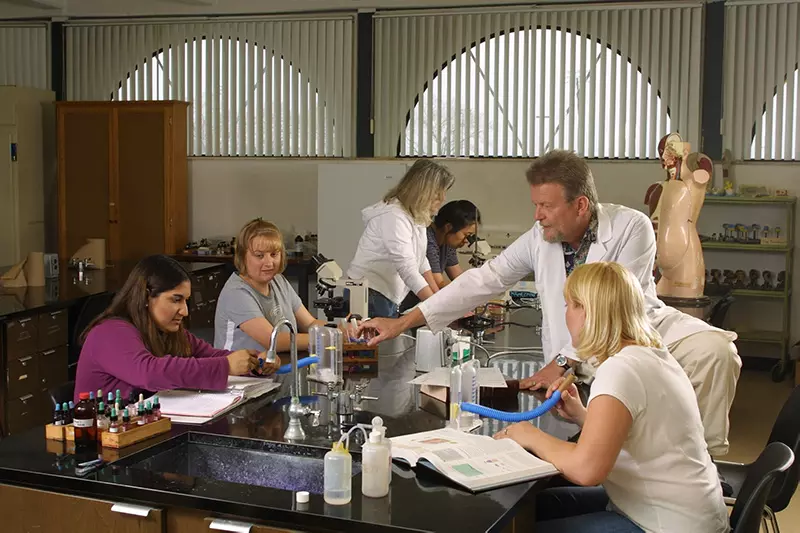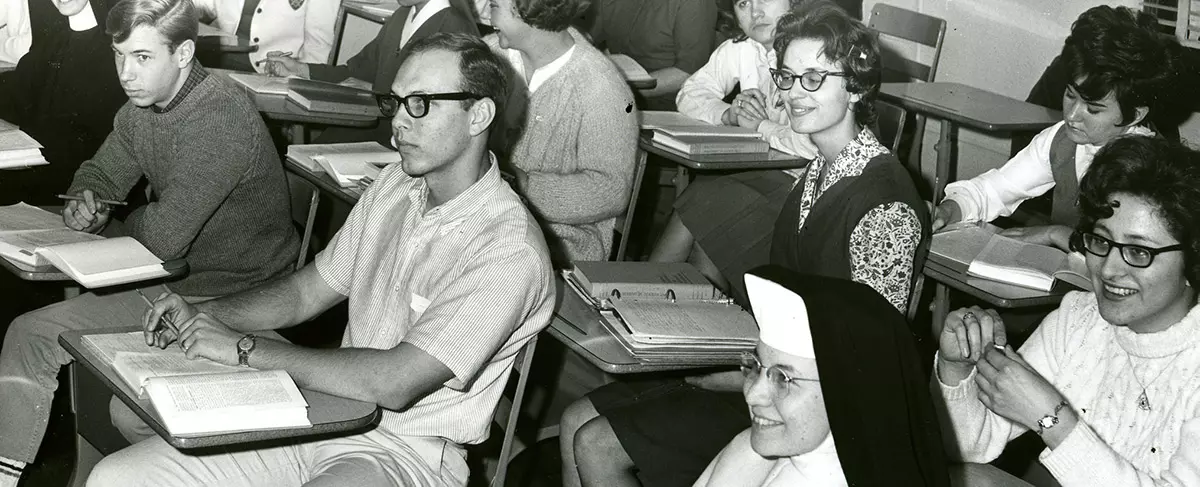Newman University: Beginning its 93rd Year
The origins of Newman University can be traced to the village of Acuto, Italy, where in 1834 a young woman named Maria De Mattias founded the order of religious women, which would become the university’s sponsoring religious congregation, the Adorers of the Blood of Christ [ASC]. Following the example of Maria—who was elevated to sainthood in 2003—the ASC were primarily a teaching order. The sisters came to the United States beginning in 1870, settling near St. Louis. In 1893, they were missioned to Westphalia, KS, and by 1902, they had come as far west as Wichita, Kansas. They purchased a six-acre piece of land, which Henry Dugan, a local farmer, had donated to the Catholic Diocese when Most Rev. J. J. Hennessy was bishop of Wichita. Here the Adorers established St. John’s Institute, a boarding school for girls. The following year (1903) a boys’ school was added. This former Dugan property would eventually become the heart of the Newman University campus.
In the 1920s, a growing demand for state certified teachers led to the formation of the Sisters College of the Diocese of Wichita, a branch of the Municipal University of Wichita [now Wichita State University]. This arrangement lasted five years. In 1933, Mother Beata Netemeyer, who was named the first provincial of the Wichita Adorers in 1929, decided to establish Sacred Heart Junior College with the guidance and assistance of Leon A. McNeill, a member of the diocesan clergy and the superintendent of the Diocesan Catholic Schools.

The college officially opened on September 12, 1933, with “no personnel, no finances and very limited facilities” at the height of the Great Depression then engulfing the world. Despite the obstacles, the college steadily developed, training the sisters as teachers and providing education for lay women in teacher education, nursing, secretarial science and home economics. The objective of the college was the “development of a true and finished Christian character” to enable students to be honorable and useful citizens of the world. The first graduating class of 1935 numbered 17.
In the 1950s, Sacred Heart had expanded its curriculum, degree offerings and faculty, and the college became a four-year institution. De Mattias Hall, a facility that included a stage, gymnasium, and music and art classrooms, was also completed; it was torn down approximately 50 years later. Men were admitted to the college in 1958 but could enroll only in the evening courses and summer sessions. In 1959, the college established a lay advisory board, which eventually led to the formation of a board of directors, now called the Board of Trustees.
In the 1960s, Sacred Heart became coeducational [1965], entered intercollegiate athletics [1967] and received accreditation from the North Central Association of Colleges and Secondary schools [1967]. Three campus buildings were completed during the decade: McNeill Hall [1961], the Marciana Heimerman, ASC Science Center [1966] and Merlini Hall [1967].
In 1973 the college’s name was changed to Kansas Newman College to reflect the continued growth of the institution, the expanded range of educational programs, and to honor St. John Henry Newman, the 19th century theologian and scholar known for his writings on the liberal arts and education. A 10-year development program, leading to the 50th anniversary of the college, was launched to raise funds, update the curriculum and strengthen faculty credentials. Through the 1970s many new programs were introduced, including women’s intercollegiate athletics [1976] and a nursing degree program [1979].
The 1980s witnessed development of strategic plans to define the mission of the college and to guide it toward the 21st century. These plans led to increased enrollment, development of programs for returning adults, and ushered in the 1990s, which were dominated by two major capital campaigns for campus improvements. Eck Hall [1995], O’Shaughnessy Sports Complex [1997], Mabee Dining Center [2000], Gorges Atrium [2000], De Mattias Fine Arts Center [2000], and Beata Hall [2000] were funded by these campaigns under the able leadership of Tarcisia Roths, ASC, who served as the 9th president of the university. Sister Tarcisia established Newman’s Mentor Wall, housed in the Gorges Atrium; she chose Sylvia Gorges, ASC, the 5th president, as her mentor. It was during the tenures of these two women religious that the majority of the Newman campus was built and renovated.
With the growth in campus facilities, as well as enrollment, academic programs and student services, the institution changed its name in July 1998 to Newman University. Today, Newman offers more than forty undergraduate and several graduate programs and now serves more than 3,000 students. As the new century unfolds, Newman continues to focus on its mission to empower students to transform society and its Catholic and ASC heritage as well as its commitment to scholarship, academic excellence, global perspective and service. Through an inspiring vision, Newman challenges itself to become a leader in Catholic higher education in the heartland of the United States and to spread this to all corners of the world as its alumni are found on each continent of the globe and are recognized leaders in their communities. Graduates of Newman University serve as doctors, nurses, lawyers, educators, research analysts, fiscal managers, musicians, artists, journalists, authors, religious leaders and in numerous other influential roles. Alumni now total 15,959 (August 20, 2019).
In the fall of 2007, Newman welcomed its 11th president, Noreen M. Carrocci, Ph.D., the first lay woman to serve in this position. Dr. Carrocci joined the Newman community as it completed another successful fund drive, resulting in construction of a 56,000 sq. ft. library and campus center named for the Dugan family [grandchildren of Henry Dugan, original owner of the land]. The campus had changed significantly with the rerouting of a city street that formerly ran through the campus, and the creation of a pedestrian mall housing Founders Plaza, dedicated in 2008 as NU celebrated its 75th anniversary. This plaza honors 230 ASC, who served on this campus since 1902; the first to be listed is Clementine Zerr, ASC. Clementine was a resilient Adorer, who accompanied sisters from the “Germanys” to the United States and was one of the first four sisters to come to Wichita in 1902. The plaza also displays a bronze statue of St. Maria De Mattias with a college-age student; she is surrounded by the names of her daughters, who have served valiantly in this corner of the vineyard. Today, sisters work and volunteer at Newman and the religious community has additional members serving on its Board of Trustees and National Alumni Board. In addition, many ASC attend events and activities on its campus.
Students come primarily from the United States, but there are a growing number of European, Latin American, African, and Asian students who matriculate at Newman University. Two new residence halls opened in 2007, Fugate Hall and Carrocci Hall; these allowed the university to house an increasing number of the student body. Dedication of the Dugan Library and Campus Center occurred on November 9, 2007 as part of the inauguration ceremonies for Dr. Carrocci. In September, 2008, the university began the celebration of its 75th anniversary [1933-2008]; the year-long events and activities concluded on September 26, 2009 with a revival of the Party on the Ponderosa. On September 19, 2010, John Henry Newman was beatified by Pope Benedict XVI in England; the university sponsored a Cardinal Newman Tour as part of its celebration of this momentous occasion.
As Newman University looks forward to its mission-driven and vision-focused future, the sponsorship, presence and prayerful support of the ASC are treasured by the Newman community. In this spirit the Strategic Plan 2009-2014 was written and approved; it provided the blueprint leading to the 80th Anniversary during which Newman University was cited with accolades from the state legislature and other regional and local organizations. A Campus Master Plan was approved in May, 2010; it provides a framework leading the university to its centennial celebration along with a new Strategic Plan for 2014-2019, which was completed and approved by the Board of Trustees in May, 2014. Renovation of Eck Hall was finished in August, 2016, and construction of the Bishop Gerber Science Center began in 2016 and was completed in time for classes in August, 2017. Dedication of the long-awaited building was held on September 21, 2017. The university began work on the next strategic plan during 2018.
On June 10-11, 2016, an All Alumni Reunion was held on the Newman campus. The 2017 Alumni Reunion occurred June 23-25; the All Academy Reunion was on June 22, 2017. The 2018 All-Alumni Weekend was on April 20-21. On Friday, April 20th the dedication of Heimerman Plaza, the Gerber Family Commons, and the Bishop Gerber Sculpture was held. This dedication was a chance for our Newman Community to honor a great part of our history. Alumni were encouraged to return to campus to see and experience for themselves their university, as it continues to grow and to soar. On September 12, 2018, the university celebrated its 85th anniversary.
Newman University celebrated the canonization of St. John Henry Newman by Pope Francis on October 13, 2019. The university sponsored a special tour group, who attended the ceremonies at the Vatican and visited special places which honor Newman University's heritage. The Newman Community also celebrated on the Wichita campus with many events and programs.
Noreen M. Carrocci, Ph.D., our 11th president, announced her retirement in the summer of 2019. The Newman University Board of Trustees (BOT) appointed a search committee to identify and hire her successor. During the transition, Teresa Hall Bartels, former chairperson of the BOT took over as interim president on Jan. 10, 2020. Bartels resigned as board chair and J. T. Klaus '87, vice-chair, took on the role while Ron Rabe became vice-chair. Kathleen S. Jagger, Ph.D., became the university's 12th president on July 1, 2020. As the world began a new decade, the Newman Community did not realize the gravity of the pandemic that would alter its normal way of operation; everyone has been profoundly affected, and together, began moving out of the darkness and into the light as the community turned to let the light of God guide the journey.

